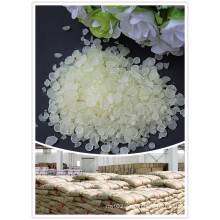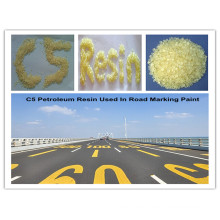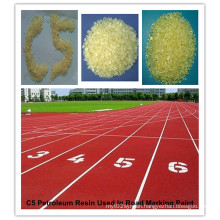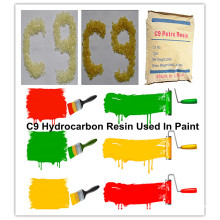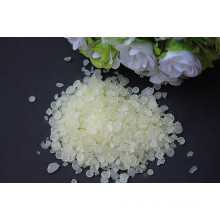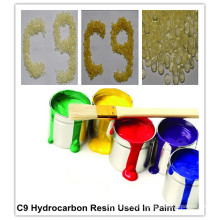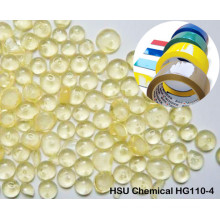In addition, factors that affect compatibility include the molecular weight and molecular weight distribution of the tackifying resin in addition to the solubility parameter values (which measure the polarity). The molecular weight is the basis of the softening point temperature, and has a great influence on the compatibility and viscoelasticity of the system. Compared with other resins with the same softening point, the rosin series resin has a narrow molecular weight distribution and has a wide range of compatibility with various elastomers. This may be because its viscosifying effect on acrylates is better than that of other kinds of tackifying resins. another reason. The overall performance of the adhesive is determined by a variety of factors, but only good compatibility is not enough, there may be other reasons.
From the above experimental results, it can be seen that among the several tackifier resins tested in this paper, the rosin has the best tackifying effect. The author selected 1# (rosin emulsion) to test several groups of adhesives, and obtained the relationship between peel strength and the amount of tackifier resin, which are listed in Table 2. At the same time, taking one group (C group) as an example, the mechanism of the rosin emulsion to increase the viscosity of the system was further discussed.
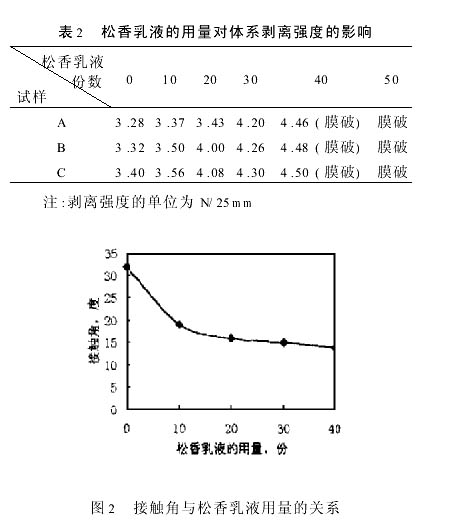
The experimental results show that the peel strength values measured by several groups of samples increase with the increase of the number of rosin emulsion parts added, and the film breakage begins to occur at 40 parts, but the peel strength before cracking can still be measured; At the beginning of the application of peel force, the film was cracked on the entire force surface at 50 points. The mechanism of this phenomenon will be discussed below.
One of the important contents of adsorption theory is that wetting is an important factor in the bonding process. The level of bonding strength depends on the wettability of the adhesive to the adherend surface and the mechanical properties of the material itself. The adhesive has good wettability on the surface of the film and is a prerequisite for uniform coating and firm adhesion. If the wettability of the adhesive and the film surface is not good, the adhesive molecules are subjected to the repulsive force, and no deep diffusion occurs in the segment, and only a little diffusion occurs in the shallow layer. At this time, the interface of the interface is clearly identified. The interface where only the attracting action of the molecular dispersion force is combined and the flow easily occurs under the action of the external force, so the adhesive strength is not high.
In addition, poor wetting can also lead to interface defects, and local stress conditions around the stress concentration can occur, resulting in reduced peel strength. The degree of wettability can be judged based on the contact angle θ between the adhesive and the adherend, θ should be less than 90°, and the smaller the θ value, the better the wettability. From the curve of the contact angle and the amount of rosin emulsion (Fig. 2), it can be seen that the addition of rosin emulsion reduces the contact angle of the adhesive to the BOPP film, demonstrating that the wetting performance is improved, and thus the peel strength is increased. The reason why the rosin emulsion improves the wettability of the adhesive to the BOPP film may be due to: first, the compatibility of the rosin emulsion and the polyacrylate emulsion is good, so that the former is uniformly dispersed in the latter; secondly, the rosin is a low molecular material. Its addition makes the molecular weight distribution of the system wider, which is beneficial to wetting.
3 Conclusion
(1) In the rosin, terpene resin, petroleum resin, and the first two compounds (1: 1), rosin has the best thickening effect, which not only increases the peel strength of the gum, but also the appearance of the system after its addition. The stability and the transparency of the coating are essentially unaffected, while other types of tackifying resins not only reduce the peel strength of the adhesive, but also have poorer remaining properties.
(2) The rosin emulsion can improve the wettability of the adhesive to the BOPP film, thereby improving the adhesive strength of the system. In the range of 0 to 50 parts, the peel strength of the adhesive increases with the increase of the amount of rosin emulsion, and the film tearing phenomenon occurs at 40 parts, and this phenomenon is more common at 50 parts. Therefore, 40 to 50 parts of rosin emulsion is suitable.
